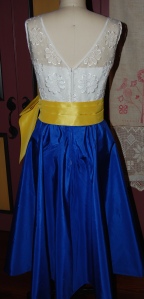Gingham fabric has been around for a long, long time. Since the early 17thcentury to be exact, although the look of the fabric has changed considerably since those days. The word “gingham” is from a Malay word “gingang” which means “with space between,” hence, striped. Yes, originally gingham was a striped fabric. It appears that it became a checked fabric sometime in the mid 1700s, and of course, that is how we think of it today.
Gingham has a fresh, timeless appeal to it, and the iterations of it are countless. The size of the checks can be absolutely miniscule or large and prominent.

Each check in this gingham is only a couple of threads wide. I do not have an example of a really large checked gingham, but you can surely visualize it.
There are two types of gingham; the entry in The Fairchild Dictionary of Fashion (Third Edition, by Charlotte Mankey Calasibetta and Phyllis Tortora; Fairchild Publications, Inc., New York, New York, c2003, page 209) explains it beautifully: “Checked ginghams are two-colored effects made by using two colors, or one color and white, for groups of yarns in both the lengthwise and crosswise. Plaid ginghams are yarn-dyed designs of several colors.”
And do you know what zephyr ginghams are? “Zephyr ginghams,” according to Fairchild’s “are made with fine, silky, mercerized yarns.” Obviously both checked and plaid ginghams can be zephyr ginghams.
And indeed, it was a zephyr plaid gingham which I used for my most recent blouse:
I purchased this fabric at the same time I ordered the fabric for my lavender gingham blouse. I still had the “blouse bug,” so I decided to go for it! I made a few tweaks to the pattern; specifically I added a tapered half inch to the lower half of the sleeves, to give me a little more ease in rolling them up. Of course, this meant I needed to add a half inch to the diameter of the cuffs. I also increased the length of the sleeve vent by about 1.25 inches. I find these changes just add a bit more finesse to the wearing of this blouse, which is super comfortable anyway.

I kept the center back pleat, as it just makes this blouse so comfortable to wear, especially on a hot summer day.
Now, do you see that double navy blue line at the center front?
That is a mistake. I thought I had calculated the grid of the plaid correctly to have a continuous pattern across the front of the blouse. About halfway through its construction, I discovered I had calculated incorrectly. At that point I did not have enough fabric left over to cut out two – or even one – new fronts, so my fate was sealed. Now I know what I did wrong, and hopefully I won’t make that mistake the next time I make a gingham blouse. (And there will be a next time, but probably not this year.)
Being a button aficionado, I of course searched again for the right buttons for this blouse. I thought about using these vintage pearl buttons with their square motif. However, at 5/8” wide, they were just too big.
 I finally admitted to myself that buttons on a blouse like this should not be the focal point; they should be delicate and discreet – which led me to this card of vintage buttons in my collection:
I finally admitted to myself that buttons on a blouse like this should not be the focal point; they should be delicate and discreet – which led me to this card of vintage buttons in my collection:
The luminosity of the pearl in these buttons actually picks up the pink in the plaid in a very subtle way – and they are definitely discreet.
Well, I don’t want to end this post without giving you a few more fun facts on gingham. Did you know that “gingham” was a colloquial term for an umbrella in the 19thcentury? Again, according to Fairchild’s Dictionary (page 462), “so called because the less expensive types were made out of gingham fabric.”
And who doesn’t know that Dorothy Gale in The Wizard of Oz wore a blue gingham dress? Or that Brigitte Bardot wore a pink gingham wedding dress (which led to a shortage of this fabric in France, according to Wikipedia)?
If you have not recently read the classic poem by Eugene Field (1850-1895), “The Gingham Dog and the Calico Cat,” it might be time to reacquaint yourself. Here is how it starts: “The gingham dog and the calico cat, side by side on the table sat.” Just the mention of the fabrics creates a mental picture of what is to ensue between these two!
There are few fashion references to gingham that are noteworthy, save for this one from interior designer Kelly Wearstler, “The best thing I ever bought is a vintage Oscar de la Renta short gingham dress that I wore to my rehearsal dinner the night before my wedding.”
And finally, this from Christian Dior on “checks” (The Little Dictionary of Fashion, by Christian Dior, Harry N. Abrams, New York, New York, 2007, page 21): “I love checks. They can be fancy and simple; elegant and easy; young and always right…. They are always in fashion … and there are so many styles of checks to choose that there will be one to suit every age and figure.”
From “always right” cotton gingham, I now head to another “always right,” forever, classic motif: polka dots – in silk! New month, new project. Happy July, everyone!









































































